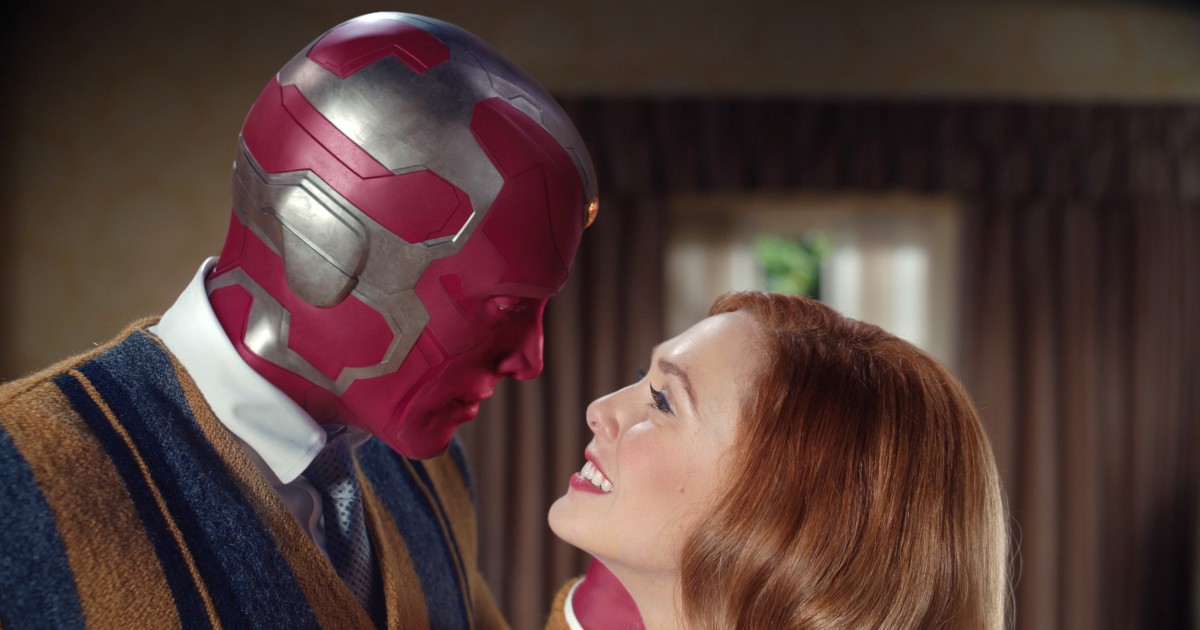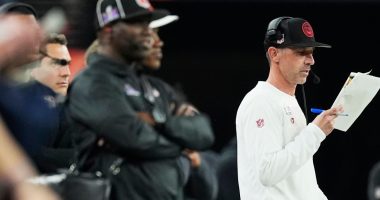
“This is our home now. I want us to fit in,” the superhero witch Wanda (Elizabeth Olsen) tells her android husband Vision (Paul Bettany) in an early episode of the new series “WandaVision.” The home she’s referring to is the suburban, retro town of Westview, where the couple have found themselves for somewhat obscure reasons. But Wanda could also be talking about the medium of television itself.
Wanda and Vision are refugees from the Marvel Cinematic Universe movies.
Wanda and Vision are refugees from the Marvel Cinematic Universe movies. The couple were last seen in “Avengers” Endgame” (2019) fighting (and in Vision’s case, being killed by) the evil and very purple cosmic killer Thanos. But somehow now they’ve landed here, in Disney+’s first MCU TV series, appearing in nine half-hour episodes instead of in a feature film. They’re out of place, and their old tricks don’t quite work. So the show is about the goofiness of superheroes in suburbia. But it’s also about how the MCU is using its film cast in a small-screen setting for the first time. It’s the MCU’s changing everything while still remaining itself, for better and worse.
In the first of the three episodes available for review, the show is shot in black and white, and Wanda and Vision appear to be living in a 1950s sitcom. Wanda cleans house; Vision goes off to work at a company where he adds numbers and tries to figure out what the company does. As the series goes on, time and references morph and blur; Disney publicity says the series’ style will move from an imitation of “I Love Lucy” to “The Brady Bunch” and on to “The Office.” Vision doesn’t generally seem to notice these changes, and Wanda may or may not be aware of them. There are signs, though (a radio speaking eerily to Wanda, time reversing, someone referring to events from the MCU films) that this isn’t just a gag but rather an indication that the world we see is a façade, à la “The Truman Show” or “The Good Place.”
Unlike in “The Truman Show,” though, the joke isn’t that the characters are incredibly normal; instead, these superheroes are bizarrely and humorously out of place. Wanda and Vision don’t fit into ’50s suburbia (or ’60s suburbia, for that matter), and they have to conceal their identities from neighbors and friends. Don’t let the boss see the food flying around the kitchen by itself while you prepare dinner, dear! Don’t let your co-worker be suspicious about how you can add those numbers so quickly, love!
So do Wanda and Vision manage to fit in? Transporting superheroes into suburbia goes off without a hitch — or rather, with enjoyably satisfying hitches. Superheroes’ hiding their secret identities is part of a long storytelling tradition, and it jibes nicely with the world of sitcom miscommunication and hijinks. Wanda and Vision at several points evoke the screwball comedy timing of the old “Superman” films with Christopher Reeve and Margot Kidder. Olsen and Bettany admittedly aren’t that good, but even the comparison is high praise.
The effort to turn the MCU into a gem of peak television is perhaps less successful. Prestige TV is the land of adventurous style and daring thematic exploration. Popcorn superhero movies, in contrast, are more predictable middlebrow fare. The MCU movies all have similar plots and style; the goal is generally to beat some bad guy using some combination of courage, resolve, digital effects, brisk pacing and quips. “WandaVision” is trying to adapt to television’s highbrow demands by ironizing television’s lowbrow past.
The result is well-worn (if still sturdy!) gags about nosy neighbors, unreasonable bosses, pregnancy and excessive drinking. “In a real magic show, everything is fake,” Wanda says with innocent enthusiasm as she prepares for a neighborhood talent show. But the fakeness here is obviously not real. It feels like a dream sequence, and not a David Lynchian one, despite his obvious influence. MCU fans will never doubt that there’s some logical explanation (or logical by superhero standards, at least).
“WandaVision” is a detour from the usual MCU formula and an exciting preview of how adventurous the MCU is willing to be with its Disney+ shows. It’s certainly more inventive and focused than most of Marvel’s dark, gritty and ultimately tedious Netflix shows, like “Daredevil,” “The Punisher” or the remarkably wretched “Iron Fist.” But “WandaVision’s” ambition also underlines certain limits in tone and ambition. It’s not willing to push the superhero genre as far as “Watchmen” or “Legion.” And if, as seems likely, the show is ultimately about grief, its concluding episodes will need to be a big step up from its early ones if it’s going to rival “Twin Peaks” or the sadly underrated “Channel Zero: No-End House.”
“WandaVision” asks, “How weird can the MCU get?” The answer is pretty weird, and in a good way. But even so, you can also tell that no one wants to disturb the neighbors that much. Given that the MCU reliably pulls in billions every year at the box office, you can see why Wanda and Vision would want to be sure that, whatever their idiosyncrasies, they still mostly fit in.
Source: | This article originally belongs to Nbcnews.com










